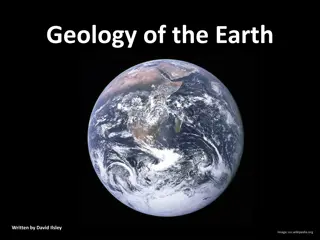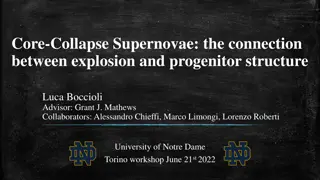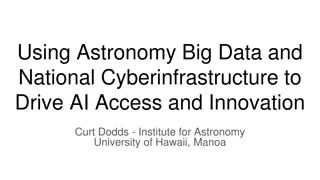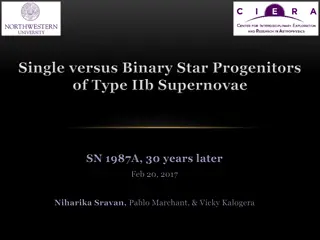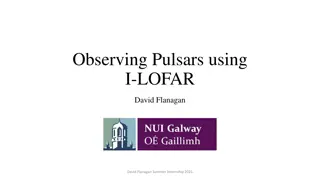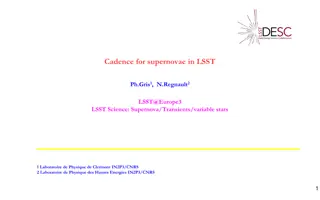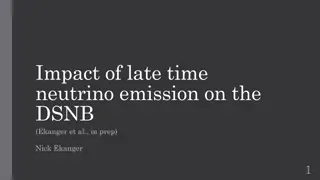Geology of the Earth
The evolution of elements in the universe began with the Big Bang, leading to the formation of hydrogen, helium, and heavier elements through stellar processes like fusion and supernovae. Our solar system formed 4.5 billion years ago from a nebula containing a variety of elements. These elements pla
4 views • 44 slides
Understanding Core-Collapse Supernovae and Progenitor Structures
Explore the intricate connection between core-collapse supernovae explosions and progenitor star structures through the research conducted by Luca Boccioli and collaborators. Delve into the complexities of the supernova mechanism, including the collapse of outer layers, core bounce, shock propagatio
0 views • 20 slides
Exploring Astronomy Big Data and Cyberinfrastructure for AI Innovation
Harnessing the power of big data in astronomy, this presentation by Curt Dodds from the Institute for Astronomy at the University of Hawaii, Manoa, delves into the utilization of national cyberinfrastructure to advance artificial intelligence access and foster innovation in the field. The discussion
0 views • 40 slides
Unveiling the Progenitors of Stripped Envelope Supernovae (SNe)
The mechanism behind the stripping of stripped-envelope SNe remains a key question linked to their progenitors. Various mechanisms such as Single Star Progenitors, Binary Star Progenitors, Stellar Winds, and Close Binary Interactions are thought to dominate the stripping process. Observations of Typ
0 views • 12 slides
The Physics of Supernovae and Neutron Stars
Explore the fascinating world of supernovae and neutron stars through historical postulations, Nobel Prize-worthy discoveries, multi-dimensional simulations, and paradigm shifts in understanding asymmetric supernovae. Dive into the complexities of core-collapse mechanisms, jet formations, and the po
0 views • 35 slides
Exploring the Fascinating World of Stars and Stellar Phenomena
Discover the mesmerizing realm of astronomy through a journey into various types of stars, including giant, supergiant, white dwarf, brown dwarf, and neutron stars. Learn about blue giants, red supergiants, white dwarfs, brown dwarfs, neutron stars, and pulsars. Explore the concept of supernovae, th
0 views • 6 slides
Exploring Pulsars with I-LOFAR: David Flanagan Summer Internship 2021
Collapsed remnants of supernovae, pulsars emit electromagnetic radiation from their magnetic poles, observed using I-LOFAR at Birr Castle. Learn about Pulsar B1929+10, I-LOFAR operations, and accessing raw data during the research internship supervised by Dr. Aaron Golden.
0 views • 19 slides
Cadence for Supernovae in LSST and Dark Energy Hubble Diagrams
This content discusses the cadence for supernovae observations in the Large Synoptic Survey Telescope (LSST) and presents Hubble diagrams related to Supernovae and Dark Energy research. The images and descriptions focus on cosmological aspects, distance moduli, observational strategies, and constrai
0 views • 21 slides
Late-Time Neutrino Emission Impact on DSNB Study
Explore the implications of late-time neutrino emission on the Diffuse Supernova Neutrino Background (DSNB) through core collapse supernovae simulations. The research delves into the dynamics of neutrino emission in different phases of supernova events and its relevance to understanding the DSNB.
0 views • 15 slides
Neutron Star Mergers and Ultra Heavy Element Cosmic Rays: Exploring Their Connection
Delve into the intriguing link between neutron star mergers and the synthesis of ultra heavy element cosmic rays. The rapid neutron capture process, known as r-process, plays a crucial role in creating elements heavier than iron through events like neutron star mergers and core-collapse supernovae.
0 views • 19 slides
